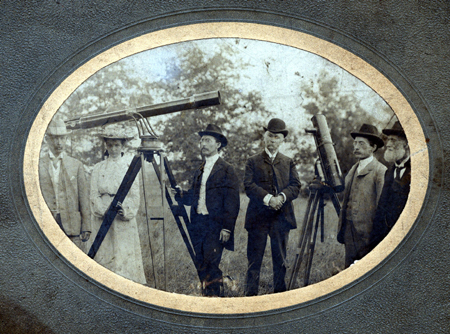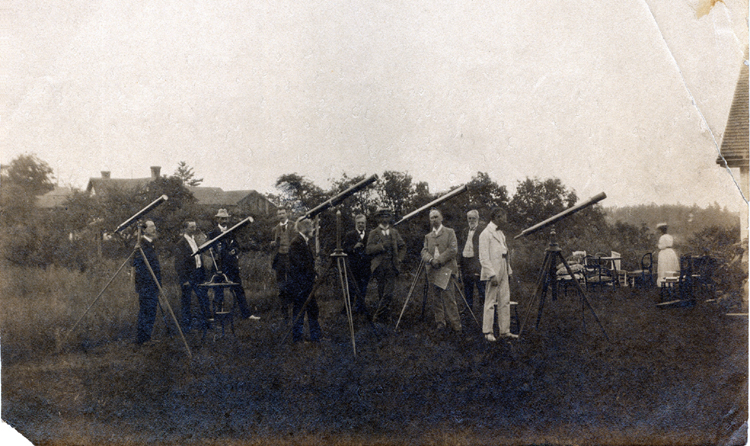Star parties are a normal phenomenon in the present universe of amateur astronomy. They come in various shapes and sizes, as mentioned in the podcast (with origins in various epochs!). One of the most useful criteria for classification is that of location: urban and semi-urban; or dark-sky.
Listings for regularly recurring star parties in North America and elsewhere can be found online, and in print. Sky and Telescope offers a judiciously selected list on its webpage. The Astronomical League lists many star parties in its calendar, although there doesn't appear to be a way to filter for the star parties alone (but the advantage of that is one can get a feeling for the range of concurrent astronomical activities happening in the republic to the south). The SkyNews site presents a listing for Canadian star parties (this year's edition is not yet up). RASC sponsored star parties are (mostly) listed on a page of the Society's site. And the webpage for the North York Astronomical Association's (NYAA) Starfest can be found here. Notices of star parties from across the globe are occasionally published in the International Astronomical Union's (IAU) Astronomy Outreach Newsletter. We have thus far not succeeded in finding a comprehensive online listing of star parties for North America, Europe, or the World. The best way to locate a star party in your area is to contact a local astronomy group near by.
Works on the origin, rise, and history of the phenomenon of star parties are surprisingly rare, as are useful histories of particular star parties. Some recent work has appeared attempting to determine the early history of the use of the terms "star party", and "star-gazing party", and the rise of the practice within RASC circles around the turn of the last century.

The RASC Archives possess three early photographs of events from ca. 1900 which we would now be inclined to label as star parties (1, 2, & 3). If so, they were almost certainly of the "closed invitation/intrinsic" type, which since about 1910 has probably become proportionally less frequent in comparison to the "open invitation / extrinsic" type typical of today (see R.A. Rosenfeld, "Earliest RASC Star Party Antecedents?", JRASC 111, 3 [2017 June], 124-128, at p. 124).

|
This "star party"took place ca. 1900-1901, on the country property of Society member D.J. Howell, in Lambton Mills, ON; D.J. Howell, "Recollections of the Early Days of the Astronomical Society", JRASC 25, 6 (1931 December), 233-236.
|
Similarities with and dissimilarities between these images and those of today's analogues are immediately apparent; among the similarities, people and apparatus are prominent; among the dissimilarities, formal attire has given way to casual clothing, the field of mainly small refractors has become a field of large Dobsonians, and, with the development of digital imaging, the star party is as likely to be captured at night as during the day. The possible implications of differences in equipment for styles of observing are easy to suggest, but the reality of the past—where it can be established—may diverge surprisingly from present assumptions regarding perceived instrumental limitations, the force of traditions, and limited expectations. During the era of the "common telescope" (ca. 1840-1925),1 DSOs (deep sky objects) were recommended as suitable objects for amateur observing in some works from the period, such as Hermann J. Klein, Star Atlas Containing Maps of all the Stars from 1 to 6.5 Magnitude Between the North Pole and 34 South Declination, and of All Nebulae and Star Clusters in the Same Region which are Visible in Telescopes of Moderate Powers. With Explanatory Text, tr. Edmond McClure (London: Society for promoting Christian Knowledge, 1901), and J.J. von Littrow, Atlas Des Gestirnten Himmels: Für Freunde Der Astronomie, ed. Karl von Littrow (Stuttgart: Verlag von Gustav Weise, 1866).
The earliest members of the Society had a choice then in what to observe. Did any of them rise to the challenge of trying to discern non-solar-system objects at the edge of detectability in their instruments? Thus far there is little evidence uncovered to indicate that they did. The history of amateur astronomy is rarely a simple mater.
—R.A. Rosenfeld
A transcript of this podcast is available.
Footnotes
- "By "common telescopes" are here intended such as are most frequently met with in private hands; achromatics with apertures of 3 to 5 inches; or reflectors of somewhat larger diameter"; T.W. Webb, Celestial Objects for Common Telescopes, ed. T.E. Espin, 5th ed., I (London New York Bombay: Longmans, Green, and Co., 1904), p. 1. ↵
